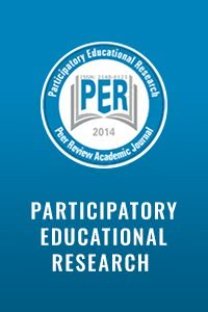Collaborative Group Activities in The Context of Learning Styles on Web 2.0 Environments: An Experimental Study
___
- Ağca, R. K. (2006). The Effects of Different Navigation Structures Based upon Learning Styles on the Success of the Student in Hypermedia Environments. Gazi University Institute of Educational Sciences. Department of Computer and Instructional Technologies. Master's thesis. Ankara.
- Aşkar, P., & Akkoyunlu, B. (1993). Kolb Learning Style Inventory. Education and Science, 87 (17), 37–47.
- Brickell, G. (1993). Navigation and learning style. Australlian Journal Of Educational Technology, 9(2), 103–114.
- Büyüköztürk, Ş. (2018). Manual of data analysis for social sciences. Ankara: Pegem Academy.
- Büyüköztürk, Ş., Çakmak, E. K., Akgün, Ö. E., Karadeniz, Ş., & Demirel, F. (2018). Scientific Research Methods in Education (25th ed.). Ankara: Pegem Academy.
- Durdu, L., & Durdu, P. O. (2016). Online Learning Environments. In K. Çağıltay & Y. Göktaş (Eds.), Fundamentals of Instructional Technologies (2nd ed., Pp. 523–525). Ankara: Pegem Academy.
- Driscoll, M. (2002). Web-Based Training: Creating E-Learning Experiences (2nd ed.). San Francisco: CA: Jossey-Bass/Pfeiffer.
- Ekici, G. (2003). Lesson Plan Examples for Teaching Based on Learning Style and Biology Lesson. Ankara: Gazi Publishing House.
- Ergül, H. (2006). Motivation Structures Affecting Academic Achievement in Online Education. The Turkish Online Journal of Educational Technology, 5 (1), 13.124-128.
- Gencel, İ. E. (2007). The Study of Adapting Kolb's Learning Styles Inventory-III Based on Experiential Learning Theory into Turkish. Dokuz Eylül University Institute of Social Sciences Journal, 9 (2), 120–139.
- Gudawardena, C. N., & McIsaac, M. S. (2003). Distance education. In D. H. Jonassen (Ed.), Handbook of Reseach on Educational Communications and Technology (2nd Editio). Mahwah, NJ: Lawrence Erlbaum Associates, Inc.
- Hargadon, S. (2009). White Paper on Educational Networking: The important role Web 2.0 will play in education. Retrieved from http://www.elluminate.com
- Horzum, M. B. (2010). Investigating teachers’ Web 2.0 tools awareness, frequency and purposes of usage in terms of different variables. International Journal of Human Sciences, 7 (1), 603–634.
- Kolb, D. A. (1999). Learning Style Inventory: Version 3. Boston, MA: Hay/McBer Training Resources Group.
- Korkmaz, Ö. (2012). A validity and reliability study of the Online Cooperative Learning Attitude Scale (OCLAS). Computer & Education, 59(4), 162–1169. https://doi.org/Doi: 10.1016/j.compedu.2012.05.021
- Korkmaz, Ö., Çakır, R., & Özden, M. Y. (2015). Investigating teachers’ Web 2.0 tools awareness, frequency and purposes of usage in terms of different variables. Gazi Journal of Educational Sciences, 1 (2), 67–86.
- Netteland, G. (2003). Improved Quality in Large-Scale Implementations of E-Learning in the Workplace – In Search of Critical Success Factors. The Quality Dialogue: Integrating Quality Cultures in Flexible, Distance and eLearning (s. 108-113). Rhodes, Greece: European Distance Education Network.
- Numanoğlu, G., & Şen, B. (2007). Learning Styles of Computer Education and Instructional Technology Students. Ahi Evran University Journal of Kırşehir Education Faculty, 8 (2).
- Özyurt, Ö., & Özyurt, H. (2015). Learning style based individualized adaptive e-learning environments: Content analysis of the articles published from 2005 to 2014. Computers in Human Behavior, 5, 349–358.
- Phipps, R. A. (2015). Measuring quality in internet-based higher education. International Higher Education, 20, 2–3.
- Pürbudak, A, Usta, E. (2019). The Effect of Digital Storytelling with Memory Supported Strategy Method on Attitude Towards Foreign Language Course. Gazi Journal of Educational Sciences, 5 (2), 95-114. Retrieved from https://dergipark.org.tr/tr/pub/gebd/issue/47331/558216
- Riding, R., & Rayner, S. (1998a). Cognitive styles and learning strategies. London: David Fulton Publishers.
- Riding, R., & Rayner, S. (1998b). Cognitive Styles and learning strategies. London: David Fulton Publishers.
- Schlosser, L. A., & Simonson, M. (2006). Distance Education: Definition and Glossary of Terms (2. b.). United States of America: IAP-Information Age Publishing, Inc.
- Stacey, E. (2007). Collaborative learning in an online environment. International Journal of E-Learning & Distance Education, 14(2), 14–33.
- Triantafillou, E., Pomportsis, A., & Demetriadis, S. (2003). The design and the formative evaluation of an adaptive educational system based on cognitive styles. Computers & Education, 41(1), 87–103.
- Tuan, H. L., Chin, C. C., & Cheng, S. F. (2005). Investigating the effectiveness of inquiry instruction on the motivation of different learning styles student. International Journal of Science and Mathematics Education, 3(4), 541–566. https://doi.org/10.1007/s10763-004-6827-8
- Uğur, B., Akkoyunlu, B., & Kurbanoğlu, S. (2011). Students’ opinions on blended learning and its implementation in terms of their learning styles. Education and Information Technologies, 16(1), 5–23. https://doi.org/10.1007/s10639-009-9109-9
- Uygungül, Ö. (2016). Effect of Creative Drama Method on Students' Attitude towards Social Studies, Academic Achi̇evement and Retention by Learning Styles. Çukurova University Institute of Social Sciences, Adana.
- Veznedaroğlu, R. L., & Özgür, A. O. (2005). Learning Styles: Definitions, models and functions. İlköğretim Online, 1–16.
- Wang, Kua Hua, T. H. Wang, W. L. W. (2006). Learning Styles And Formative Strategy: Enhancing Student Achievement in Web-Based Learning. Journal Of Computer Assisted Learning, 22(3), 207–2017.
- Zhu, C. (2012). Student satisfaction, performance, and knowledge construction in online collaborative learning. S. Educational Technology & Society, 15(1), 127–136.
- ISSN: 2148-6123
- Yayın Aralığı: Yılda 6 Sayı
- Başlangıç: 2014
- Yayıncı: Özgen KORKMAZ
Kadir KABAK, Agah Tuğrul KORUCU
Ayşegül PÜRBUDAK, Ertuğrul USTA
Ferhat KARAKAYA, Merve ADIGÜZEL, Gökşen ÜÇÜNCÜ, Osman ÇİMEN, Mehmet YILMAZ
Ceyhun KARABIYIK, Meltem Huri BATURAY, Muzaffer ÖZDEMİR
Angeliki LİTHOXOİDOU, Evangelia SEİRA, Agapi VRANTSİ, Catherine DİMİTRİADOU
